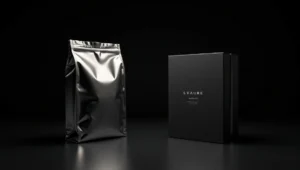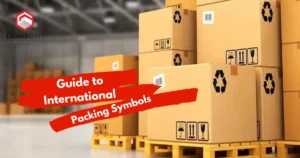Cardstock Packaging Types
Cardstock packaging types are diverse and versatile, catering to various industries’ needs for Packaging Solutions. From protecting delicate items during transportation to augmenting product presentation on shelves, cardstock packaging comes in various types, each with its unique characteristics and applications.
Double Wall
Double wall cardstock packaging consists of two layers of corrugated material sandwiched between three layers of paperboard. This type offers improved durability and strength, making it ideal for heavy or fragile items requiring extra protection during shipping and handling.
Standard Double Wall Cardstock Packaging Dimensions
12 x 12 x 12 inches (30.48 x 30.48 x 30.48 cm) and (304.8 x 304.8 x 304.8 mm)
Single Face
Single face cardstock packaging features one layer of corrugated material adhered to one side of paperboard. It provides moderate protection and cushioning, suitable for lightweight products or as inner packaging within larger containers.
Standard Single Face Cardstock Packaging Dimensions
12 x 12 x 6 inches (30.48 x 30.48 x 15.24 cm) and (304.8 x 304.8 x 152.4 mm)
Single Wall
Single wall cardstock packaging comprises a single layer of corrugated material sandwiched between two layers of paperboard. It strikes a balance between strength and affordability, commonly used for shipping boxes, Mailer Boxes, and product displays.
Standard Single Wall Cardstock Packaging Dimensions
12 x 12 x 8 inches (30.48 x 30.48 x 20.32 cm) and (304.8 x 304.8 x 203.2 mm)
Triple Wall
Triple wall cardstock packaging consists of three layers of corrugated material interleaved with four layers of paperboard. This heavy-duty option offers maximum strength and protection, often utilized for industrial packaging, large appliances, and machinery.
Standard Triple Wall Cardstock Packaging Dimensions
12 x 12 x 14 inches (30.48 x 30.48 x 35.56 cm) and (304.8 x 304.8 x 355.6 mm)
Bux board
Bux board is a type of rigid cardstock packaging made from thick paperboard or cardboard. It is commonly used for packaging luxury items, cosmetics, and electronics, providing a premium look and feel while offering sufficient protection during transit.
Standard Bux board Packaging Dimensions
10 x 8 x 4 inches (25.4 x 20.32 x 10.16 cm) and (254 x 203.2 x 101.6 mm)
Cardboard
Cardboard is a generic term referring to thick paper stock or paperboard. It is versatile and can be used for various packaging applications, from shipping boxes to Retail Packaging, depending on its thickness and strength.
Standard Cardboard Box Dimensions
14 x 10 x 4 inches (35.56 x 25.4 x 10.16 cm) and (355.6 x 254 x 101.6 mm)
Paperboard
Paperboard, also known as chipboard or binder’s board, is a thick paper-based material often used for Packaging Boxes, partitions, and dividers. It comes in various thicknesses and can be coated or uncoated, depending on the desired finish and functionality.
Standard Paperboard Box Dimensions
8 x 6 x 2 inches (20.32 x 15.24 x 5.08 cm) and (203.2 x 152.4 x 50.8 mm)
Bleached Solid
Bleached solid cardstock packaging undergoes a bleaching process to achieve a clean, white appearance. It offers a primeval aisle for printing high-quality graphics and branding, commonly used for retail packaging and consumer goods.
Standard Bleached Solid Cardstock Packaging Dimensions
10 x 8 x 6 inches (25.4 x 20.32 x 15.24 cm) and (254 x 203.2 x 152.4 mm)
Corrugated Boxes
Corrugated boxes are made from corrugated fiberboard, consisting of a fluted corrugated sheet sandwiched between two flat linerboards. They are lightweight yet sturdy, offering excellent protection against shocks and vibrations during shipping and handling.
Standard Corrugated Box Dimensions
12 x 10 x 8 inches (30.48 x 25.4 x 20.32 cm) and (304.8 x 254 x 203.2 mm)
Corrugated Fiberboard
Corrugated fiberboard is a type of paper-based material consisting of a fluted corrugated medium glued between two flat linerboards. It provides strength, cushioning, and rigidity, making it ideal for packaging fragile or heavy items.
Standard Corrugated Fiberboard Box Dimensions
14 x 10 x 6 inches (35.56 x 25.4 x 15.24 cm) and (355.6 x 254 x 152.4 mm)
Kraft Paper
Kraft paper is a durable and eco-friendly material made from wood pulp, known for its strength and resistance to tearing. It is commonly used for packaging products that require breathability and moisture resistance, such as food items, textiles, and hardware.
Standard Kraft Paper Box Dimensions
12 x 8 x 4 inches (30.48 x 20.32 x 10.16 cm) and (304.8 x 203.2 x 101.6 mm)
Paperboard Carton or Box
A paperboard carton or box is a container made entirely from paperboard material, offering lightweight yet sturdy packaging solutions for various industries. They are customizable, recyclable, and often used for retail packaging, gift boxes, and product displays.
Standard Paperboard Carton or Box Dimensions
10 x 6 x 4 inches (25.4 x 15.24 x 10.16 cm) and (254 x 152.4 x 101.6 mm)
Gray Cardboard
Gray cardboard, also known as greyboard or chipboard, is a dense and rigid type of paperboard made from recycled paper materials. It provides structural support and protection, commonly used for backing boards, book covers, and rigid packaging.
Standard Gray Cardboard Box Dimensions
12 x 10 x 6 inches (30.48 x 25.4 x 15.24 cm) and (304.8 x 254 x 152.4 mm)
Honeycomb Cardboard
Honeycomb cardboard features a unique hexagonal cell structure sandwiched between two layers of paperboard or cardboard. This design provides exceptional strength and cushioning, making it suitable for heavy-duty packaging, furniture protection, and automotive components.
Standard Honeycomb Cardboard Box Dimensions
14 x 12 x 10 inches (35.56 x 30.48 x 25.4 cm) and (355.6 x 304.8 x 254 mm)
Final Thoughts
Cardstock packaging types offer a wide range of options to meet various packaging needs across industries. From lightweight cartons to heavy-duty boxes, each type provides unique benefits in terms of strength, durability, and presentation. Understanding the characteristics and applications of different cardstock packaging types is essential for selecting the most suitable solution for specific products and shipping requirements. Whether it is protecting delicate items during transit or showcasing products on retail shelves, choosing the right cardstock packaging can improve brand image, minimize damage, and improve overall customer satisfaction.
Frequently Asked Questions
What type of cardstock is used for packaging?
Cardstock used for packaging varies depending on the application, ranging from lightweight paperboard for retail packaging to heavy-duty corrugated fiberboard for shipping boxes.
Is cardstock a type of cardboard?
Yes, cardstock is a type of thick paper or paperboard commonly used for various purposes, including crafting, printing, and packaging. It is often thicker and more durable than standard paper but thinner than cardboard.
What are the types of paper-based packaging?
Paper-based packaging includes various types such as cardboard, paperboard, corrugated fiberboard, chipboard, and honeycomb cardboard, each offering unique characteristics and applications in packaging.
What type of packaging is cardboard?
Cardboard is a type of paper-based packaging commonly used for making boxes, cartons, and containers. It provides structural support and protection for a wide range of products during transportation and storage.
What paper type is cardstock?
Cardstock is a thick, sturdy paper or paperboard often used for crafting, printing, and packaging. It is available in various weights and finishes, making it suitable for different applications.
What is the most common cardstock?
The most common type of cardstock is usually around 65 to 80 lbs (175 to 216 gsm) in weight and comes in a smooth or textured finish. It is widely used for crafting, printing, and basic packaging needs.
What is the GSM of cardstock?
The GSM (Grams per Square Meter) of cardstock typically ranges from 150 to 300 GSM, depending on the thickness and intended use. Heavier GSM cardstock is thicker and more durable, suitable for premium packaging applications.
What is standard cardstock?
Standard cardstock refers to a medium-weight paperboard commonly used for printing, crafting, and basic packaging. It is available in various colors, textures, and finishes, providing versatility for different projects.
What is PVC cardstock?
PVC cardstock is a type of synthetic cardstock made from polyvinyl chloride (PVC) material. It offers durability, water-resistance, and flexibility, making it suitable for applications such as ID cards, membership cards, and signage.
Is cardstock good for packaging?
Yes, cardstock is suitable for packaging depending on the application and requirements. It provides structural support, durability, and printing capabilities, making it ideal for retail packaging, product displays, and lightweight shipping needs.
What is GSM in packaging?
GSM, or Grams per Square Meter, is a measurement unit used to denote the weight or thickness of paper and paperboard materials. In packaging, GSM indicates the strength, durability, and stiffness of the material.
Is cardstock different than paper?
Yes, cardstock is different from standard paper in terms of thickness, weight, and durability. Cardstock is thicker and sturdier than regular paper, making it suitable for various applications such as printing, crafting, and packaging.
What paper is best for packaging?
The best paper for packaging depends on the specific requirements of the product being packaged. Cardboard, corrugated fiberboard, and heavy-duty paperboard are commonly used for their strength, durability, and protective properties.
What is the best cardstock for a box?
The best cardstock for a box depends on the box’s intended use and the product it will contain. For lightweight items, medium-weight cardstock (around 65 to 80 lbs) is sufficient, while heavier items may require thicker cardstock or corrugated fiberboard.
What is another name for cardstock?
Another name for cardstock is cover paper or cover stock. It is also sometimes referred to as pasteboard, depending on its thickness and intended use in printing, crafting, or packaging.
What is the use of cardstock?
Cardstock has various uses, including crafting, printing, packaging, and stationery. It is commonly used for making greeting cards, invitations, business cards, product packaging, and DIY projects due to its thickness and durability.
Can cardstock be laminated?
Yes, cardstock can be laminated to improve its durability, water-resistance, and appearance. Lamination involves applying a thin layer of plastic film onto the cardstock surface, protecting it from wear and tear while providing a glossy or matte finish.
What is the thickness of cardstock?
The thickness of cardstock varies depending on its weight, typically ranging from 0.2 to 0.5 millimeters (0.0079 to 0.0197 inches). Heavier cardstock is thicker and more durable, suitable for applications requiring extra strength and rigidity.
What size paper is cardstock?
Cardstock is available in various sizes, including standard letter size (8.5 x 11 inches or 21.6 x 27.9 centimeters) and larger sizes such as 12 x 12 inches (30.5 x 30.5 centimeters) or A4 size (21 x 29.7 centimeters).
What is the difference between cardstock and cardboard?
The main difference between cardstock and cardboard lies in their thickness and intended use. Cardstock is thinner and more flexible, commonly used for printing, crafting, and lightweight packaging, while cardboard is thicker and sturdier, primarily used for making boxes and heavy-duty packaging.








